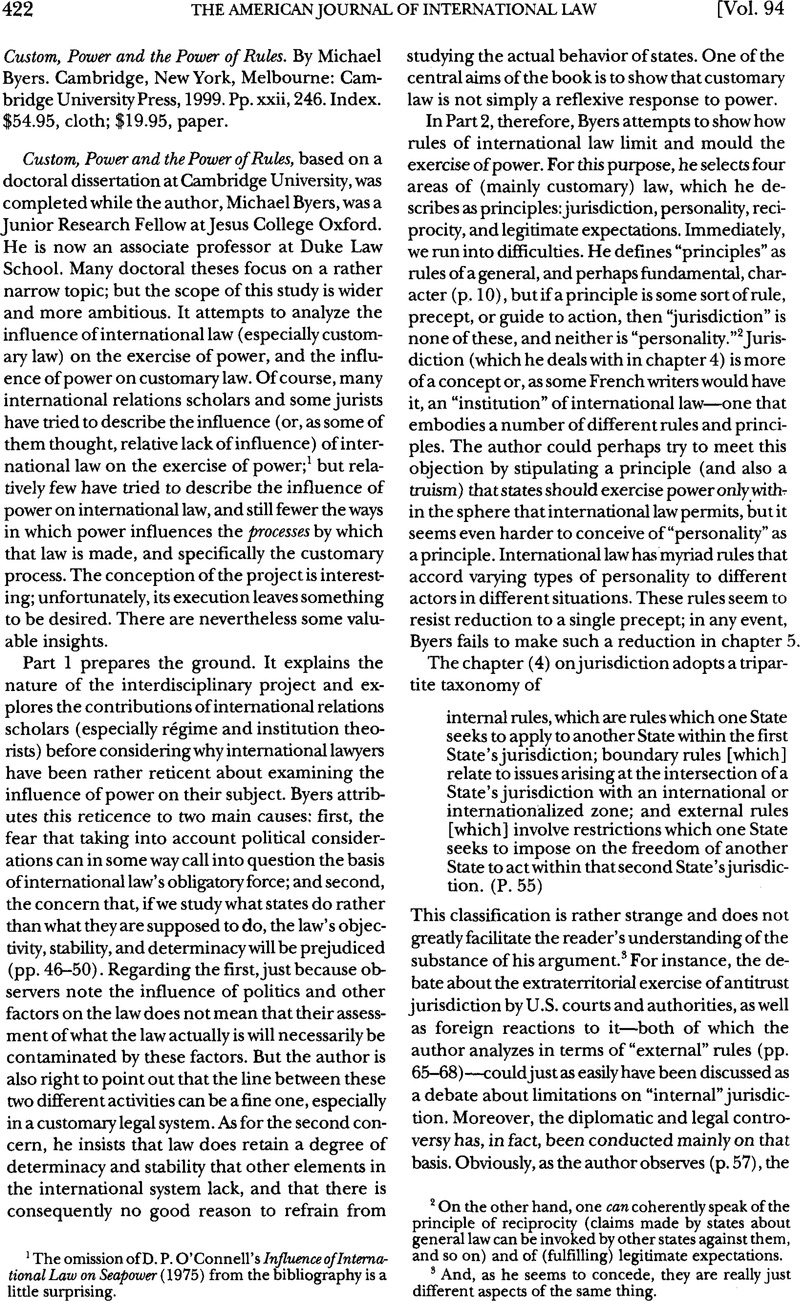No CrossRef data available.
Article contents
Custom, Power and the Power of Rules. ByMichael Byers. New York:Melbourne: Cambridge University Press,1999. Pp. xxii, 246Index. $54.95, cloth; $19.95, paper
Published online by Cambridge University Press: 27 February 2017
Abstract

- Type
- Book Reviews and Notes
- Information
- Copyright
- Copyright © American Society of International Law 2000
References
1 The omission of D. P. O’Connell’s Influence of International Law on Seapower (1975) from the bibliography is a little surprising.
2 On the other hand, one can coherently speak of the principle of reciprocity (claims made by states about general law can be invoked by other states against them, and so on) and of (fulfilling) legitimate expectations.
3 And, as he seems to concede, they are really just different aspects of the same thing.
4 In the context of this extension of territorial waters claims, Byers later (p. 117) attacks Jennings’s reasoningin asserting (in 1967) that only the three-mile limit was generally opposable to states. See General Course on Principles of Public International Law, 121 Recueil des Cours 323, 383 (1967). Byers’s style is particularly opaque here. But his argument seems to be that, because the territorial sea limit is a “boundary rule” creating obligations both towards and on the part of coastal states, it is not logically possible to have a rule that says that a three-mile limit is opposable against oKstates, but any breadth in excess of three miles only against those who claim and recognize the wider limit. Contrary to what Byers seems to think, there is nothing contradictory or asymmetrical about this. A “three-miler,” in refusing to recognize more extensive claims, would not claim more than three miles for itself. No doubt it is possible to debate whether the facts warranted the legal interpretation that Jennings placed on them at that time; but Byers is attacking his logic, not his assessment. It does not seem to be Jennings who is being logically incoherent here.
5 One could well add “internal rules” because the other types of jurisdictional rule are their counterparts.
6 This reviewer has himself, in writings going back as far as 1980, repeatedly made the same suggestion concerning legitimate expectations as an explanation of (the binding force of) certain processes we call the “sources” of international law. See, e.g., Maurice Mendelson, The Legal Character of General Assembly Resolutions: Some Considerations of Principle, in Legal Aspects of the New International Economic Order 95 (K. Hossain ed., 1980); Maurice Mendelson, The Subjective Element in Customary International Law, 1995 Brit. Y.B. Int’l L. 177; Maurice Mendelson, The Formation of Customary Intemational Law, 272 Recueil des Cours 155 (1998); see also 3rd Interim Report of the Committee on the Formation of Customary (General) International Law, in International Law Association, Report of the 67th Conference 623 (1996) (Maurice Mendelson, committee chair). See also the summary of the discussion of the 4th Interim Report of the Committee, in International Law Association, Report of the 68th Conference 336, 338 (1998); Byers participated in this meeting (see p. 343), as well as several earlier ones in which these ideas were developed by the reviewer.
7 Martti Koskenniemi, The Pull of the Mainstream, 1990 Mich. L. Rev. 1946.
8 See, for instance, the items cited supra note 6 (save for the first).
9 Though, to be fair, there are quite a few places where examples are given.




